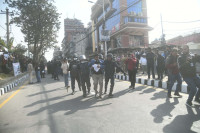Opinion
Oh no, not again
Road accidents kill around 1.3 million people worldwide and 2,000 in Nepal each year. The death rate per 100,000 motor vehicles is 400 in Nepal, 130 in India and 1,020 in Bangladesh.
Ashish Gajurel
Road accidents kill around 1.3 million people worldwide and 2,000 in Nepal each year. The death rate per 100,000 motor vehicles is 400 in Nepal, 130 in India and 1,020 in Bangladesh. In the developed countries, the fatality rate is very low: 6.5 in Japan, 7 in Germany, 5 in Sweden and 13 in the United States. On October 28, a Kathmandu-bound bus originating in Saptari plunged into the Trishuli River, killing 31 people. Following the tragedy, authorities responsible for road safety are showing increased concern over ways to improve road safety. A probe committee has been formed to identify the causes of the accident. While we wait for the findings, it has to be understood that in a mountainous country with serpentine roads, when a vehicle skids off the road, death is almost inevitable.
According to the Economic Survey 2014-15, Nepal has 80,078 km of roads, 26,935 km of which were built by the Department of Roads and the rest by local bodies. Roads built by local bodies are primarily for connectivity and do not follow prescribed engineering standards. A mere 16 percent of the roads are blacktopped, and the rest are in a miserable condition. Owing to the topography, most of the roads are narrow with sharp curves and a high gradient. Coupled with this are problems of poor visibility, lack of properly covered drainage systems and the absence of lane marking on the roads that increase the risk of road accidents. We have given priority to improving connectivity as a result of which we have compromised on road safety standards. Due to this weakness, even a minor careless moment on the part of the driver can result in disaster.
Road culture upgrade
In addition to driving skills, a driver also needs to have good attitudes and should understand that it is his responsibility to ensure that the passengers reach their destination safely. Likewise, pedestrians must walk on the sidewalk, and if there is none, they should walk on the extreme right facing vehicles coming towards them. Both passengers and drivers must observe strict discipline inside the vehicle. Any kind of disturbance should be avoided as it may distract the driver and cause an accident. Drivers are forbidden to drive more than 250 km or 6 hours continuously, but this rule has not been implemented strictly. During the annual Dashain festival exodus, drivers have been known to drive continuously for two to three days without sufficient sleep.
While the licensing process has been improved, we still lack a systematic road test to gauge practical skills. Furthermore, our regime does not stress on the adoption of safety measures by drivers. It has also been found that passengers sometimes force drivers to drive fast. As passengers, we should not act in this way. Travelling in a vehicle that is not well maintained is inviting accidents to occur. Public vehicles in Nepal are rarely serviced in a timely manner. The government has only one vehicle test centre which is also not in operation. To reduce the risk of accidents due to poor vehicle conditions, the government must strictly implement vehicle test regulations. Towards this end, the government can authorise the private sector to conduct tests with clear technical standards, and vehicle owners should be required to submit test certificates to the authorities at least four times a year.
Public vehicle operators also need to understand their responsibility to deliver passengers to their destinations safely, for which periodic maintenance is a must. Bus companies must avoid overloading their vehicles and cramming passengers beyond the safe capacity. Nepal faces a major challenge in implementing road safety regulations. Many road users are unaware of traffic rules, and those who are aware blatantly disobey them. The entire traffic system is managed and operated manually, making rule enforcement very difficult. Without adequate tools, it is impossible for a traffic policeman to check whether a driver has been driving continuously for more than 6 hours or 250 km.
Enforce standards
Drivers do not maintain lane discipline, violate speed limits and even overtake on the wrong side. Pedestrians, on the other hand, do not use proper crossing points. Violators are not penalised as severely as they are in the developed countries. The fine for jumping a red light in Nepal ranges from Rs500-1,000 while in Germany the motorist is fined Rs10,000-15,000 and given a penalty point. Road accidents cannot be completely eliminated, but the risks related to human life can be minimised to a large extent. Countries like Germany, Finland and Sweden focus on building proper road infrastructure to reduce accidents. For instance, in Sweden, the road infrastructure is built in such a way that it will correct the mistakes of the driver. As humans, people do make mistakes, and it is necessary to take this into account when building infrastructure.
In order to improve road safety in Nepal, the government must design and enforce road standards during construction and initiate processes for road safety audits at the earliest. Furthermore, based on the audit reports, poor quality roads should be upgraded. Most of the roads in Nepal pass through mountainous areas, but they lack guard rails and covered drainage and are usually covered with potholes and cracks. The government should form an empowered road safety council and entrust it with the responsibility of ensuring road safety. Furthermore, there should be strict monitoring of vehicles. Public transport operators should have their vehicles tested and submit a report at least four times a year.
Traffic rule violators must be strictly penalised so that they do not repeat mistakes, and enforcement must be done through the use of state-of-the-art technology. Bus operators must realise that it is their responsibility to deliver passengers to their destination safely and ply vehicles which are in good condition with a skilled driver. Road safety must be viewed as a system that considers the condition of the road, condition of the vehicle, enforcement of traffic rules and responsible behaviour of drivers and pedestrians.
Gajurel is a transport and traffic engineer




 6.12°C Kathmandu
6.12°C Kathmandu










